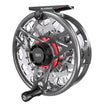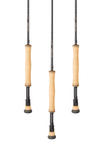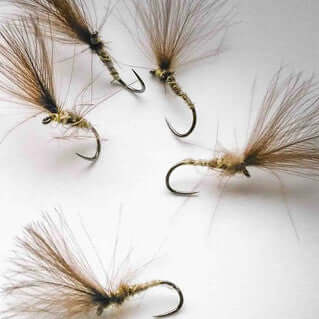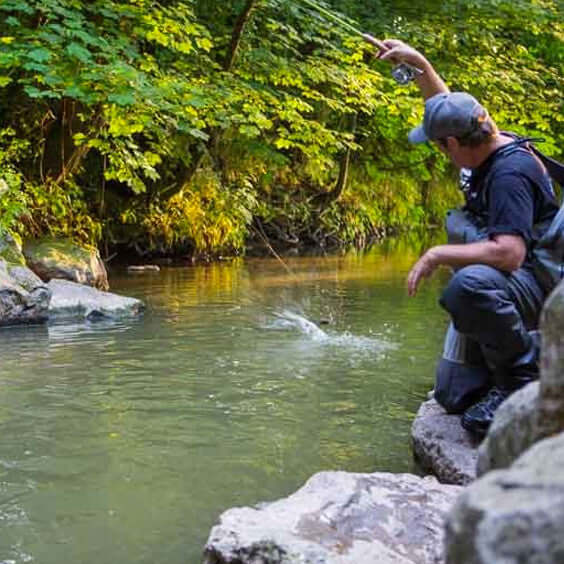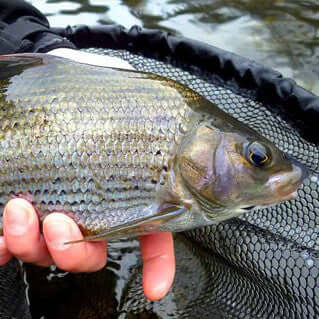The plume tip, presented properly, is my signature fly. It is never rejected and why would it be It is the perfect, generalised impression of the hatching, or hatched, upwing, or midge, with no embellishment, no trigger feature beyond its lifelike profile and built-in, intrinsic structure, as of the naturals on the water’s surface.

There is much we can do to ruin it. We can use more than two CDC plume tips, as I tried for so long, yearning for extra buoyancy or longevity, only to find that less is more, and two, with the faint dub of CDC in the thorax, is all it takes to achieve the impression of the natural, and to have the dynamics right. Tie in three, or more, and the effect is shattered. Suddenly we have bulk, and opacity and a harder outline and profile. We lose the impression of natural structure. And, finally, we learn, because such offerings are all too often rejected, by grayling, and even by typically more accommodating trout. See this a few hundred times, and you learn to reduce it all to what nature is telling us. So, ignore the urge to try to find that trigger colour, resist the temptation to fiddle with the structure to achieve better profile, or buoyancy, or anything. Absolutely resist the desire to add a hackle. The plume tip as I give it to you here, is perfection, the ultimate refinement in fly design and presentation, even in its sublime simplicity, its reduced form.
It has all condensed down to this for me, to the plume tip, on a short length of tippet running off a Jeremy Lucas Dry Fly Line, the line for which I waited almost all of those fifty years, knowing all the time, deep down, what I wanted; some modern version of an old silk line, with none of the failings of this traditional material, and none of the (even worse) failings of thick, ‘conventional’ polymer lines. I came close, with French leader, and my own adaptation of this, a presentation-orientated dry fly leader, but all has been rendered obsolete by Sunray’s JL Dry Fly Line. But nothing is ever going to render the plume tip obsolete, anymore than Arthur Cove’s or Frank Sawyer’s pheasant tails will become obsolete. It’s not going to happen.
Nature's signature.
Yes, I do, sometimes, fish other flies. I double nymph a bit in the winter, for grayling, and I fish duo, with an Oppo, during inclement conditions on the river, but this is merely as needs must, pragmatism. It does not give me the overwhelming sense of wonder, of refinement and elegance, and yet simplicity, as does the plume tip. From some time in March all the way through to November, on every river I know, trout and grayling are looking upwards, watching, ever alert for those surface bound emergers and duns, and spinners; the great summer bounty, and the easiest target food forms that exist. A plume tip mimics this; nature’s signature.
Combination of this, with a suitable, very soft rod like the Zero or Volition JL and the plume tip is what I refer to as the ultimate refinement in our sport. Really. Don’t try to embellish. Don’t search for triggers. The fly, in its raw form is all the trigger you will ever need. And don’t worry about the prescription. If you don’t have heron herl, then use something else; use cock pheasant tail or greylag goose secondary, or just tying thread. Prescriptive fly tying is at worst a nonsense, and at best it is just adherence to a tradition and an art form. Practical, effective, pragmatic fly fishing, and general fly representation, is what I seek, and the plume tip achieves this, perfectly.
The Tying.
My hook has been the Tiemco 103BL, but there are (Japanese) substitutes which are marginally better (from Polish Quills) - because they are stronger with no appreciable extra mass. A 17 Tiemco 103 is a bit springy - it can open on a fast moving trout (or if the rod is too stiff). The 19 and 21, however, are perfect. They do not open, but rather just ‘bed-in’. You need just three sizes; 17, 19 and 21. The 19 is the fundamental. 17, even among much larger March Browns, danicas and olive uprights, is pushing it, but early in the year you can get away with it. Never, ever, worry that your fly is too small. For wild fish it never will be. It can only be too big. This is one of the great, great secrets in the sport. So, think 19 as the standard, and if this is rejected drop down to a 21.
Choose a fine yellow thread - I use Bennecci 12/0 - and lay a foundation from eye to bend. Tie in a single strand of heron herl (primary or secondary). Wind the thread back up to the thorax region where you tie in two CDC plume tips, facing forwards over the eye, shuttle-cock style. The length of plume should be somewhere about that of the shank, as a rough guide. Don’t get hung up on the quality of the CDC. Just some basic mallard is fine, with plenty of structure to it. CDC does not float because of any oil it contains (which it barely does), but by virtue of its wonderful filigree structure - its vast surface area. And don’t be tempted to go for the ‘oiler puffs’ which are more dense, and more oily, and simply do not have the lovely up-wing profile or delicacy. Trim off the butts, in the thorax region. Wind the heron herl up to the thorax and catch in with the thread. Subtle now: wind the thread in open turns (it takes two) back to the bend, then back up to the thorax (another two).
This is almost invisible, but protects the herl from breaking and unwinding, and also blends in a bit more yellow, accentuating the olive colour in combination with the grey heron. You now have the thread hanging down at the thorax. Strip off half a dozen fibres (plus or minus a number!) of CDC from the trimmed off butts and loosely dub these to form a chaos of thorax. Just think that you are trying to achieve the impression of insect legs, pushing free of the nymphal shuck. This dubbing also increases buoyancy, exactly where is is needed, in the thorax. The abdomen, hook bend and point ideally lie in and below the film, while the thorax provides the footprint, with the wing in its entirety above the surface. You’re almost there. Wind the thread (and great if you still have a few strands of CDC trapped there) in front of the wing, close to the eye. Half a dozen turns, pushing up against the wing, which cocks it into a more upright position, and a double whip finish completes the fly.
Simplicity.
Keep with this simplicity. Try not to complicate in any way. You will learn the proportions. By the time you’ve tied a hundred or so, and fished them, you will have learned all the subtleties, and understand how I (and I am absolutely NOT a good fly tyer; rather a pragmatist) can say that the plume tip is never rejected. Plume tips are not ‘one fish flies’, anymore than any properly tied CDC fly should be considered as such. They need simple management, that’s all. Blow the spray off them and then dry, bringing them back to original structure by rubbing on dry cotton, amadou or similar. Never grease a plume tip, or any CDC fly. It takes seconds and is merely part of the fly fishing process, conducted subconsciously, while you are searching for the next target fish. You can use the same fly all day long, as I often do.






